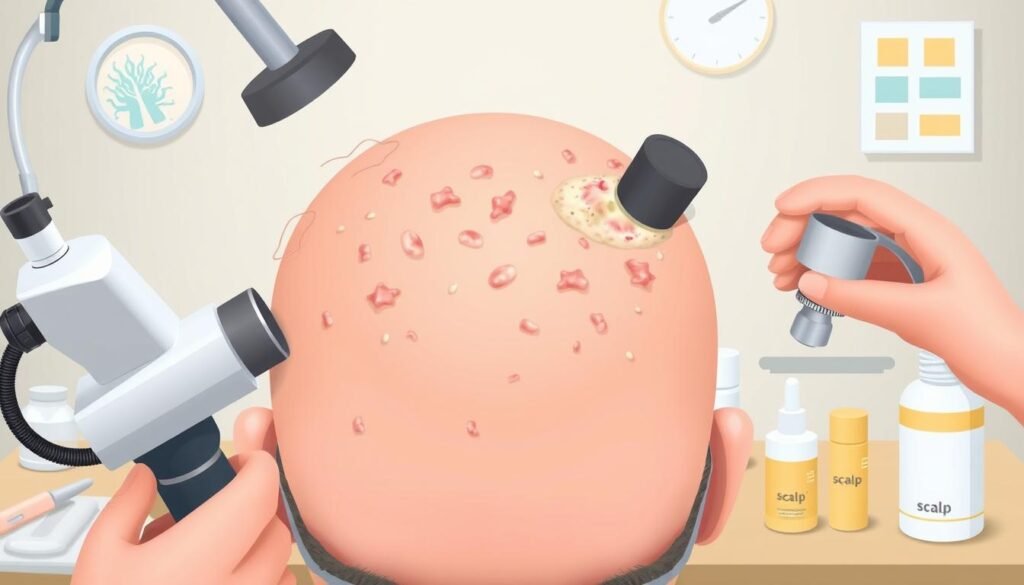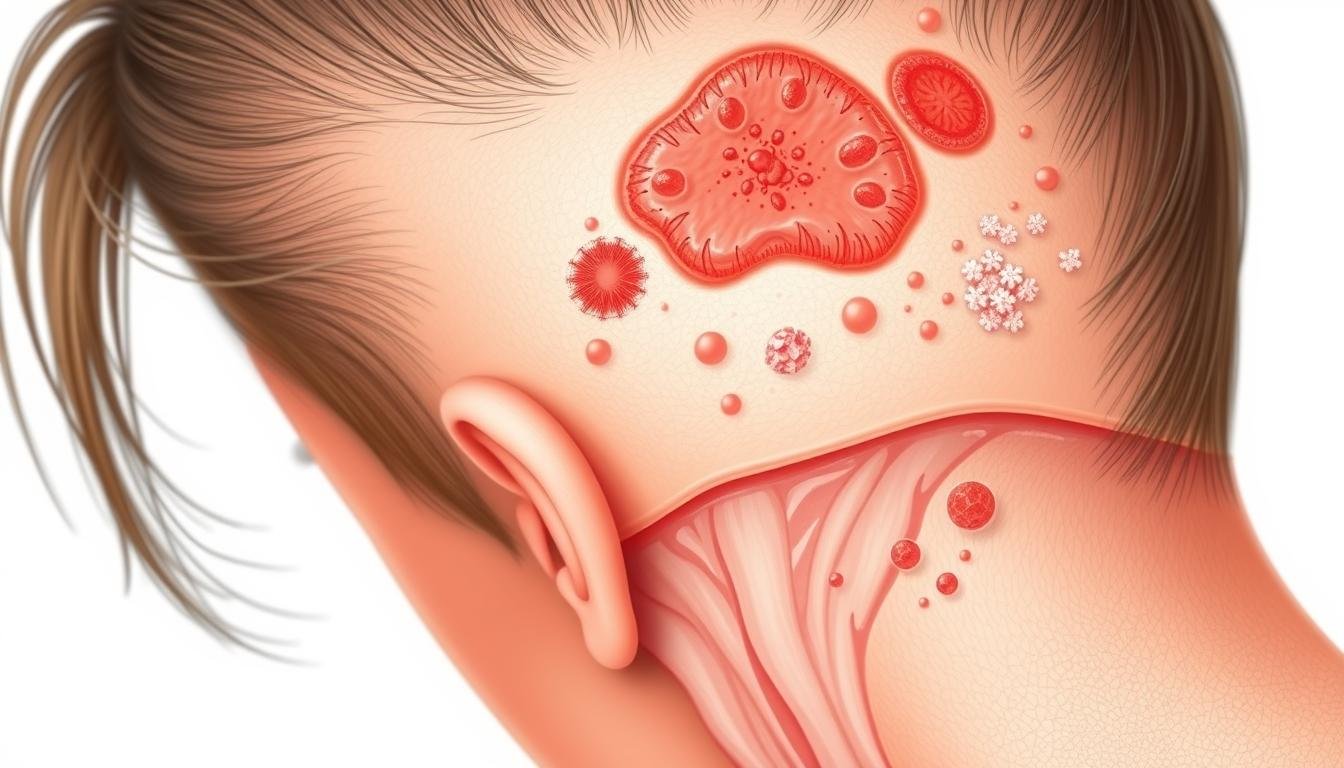Ever felt that annoying itch on your scalp that just won’t go away? A scalp yeast infection can turn a small itch into a big problem. It can make everyday life uncomfortable and affect how you feel about yourself.
A scalp yeast infection is a fungal problem that can make your scalp a battleground of discomfort. It’s mainly caused by Candida albicans, which loves warm, dark places like our scalp. Knowing about this yeast is important for managing the infection.
Scalp yeast infections are more common than you might think. They can cause itching, flaking, and irritation that’s worse than regular dandruff. While most people can get rid of them easily, catching it early is key to avoiding bigger issues.
Key Takeaways
- Scalp yeast infections are fungal infections mainly caused by Candida albicans
- They thrive in warm, moist environments on the scalp
- Symptoms include itching, flaking, and possible red patches
- Most infections are benign and treatable in healthy individuals
- Early detection and proper treatment can prevent further complications
Understanding Scalp Yeast Infection
Scalp yeast infections are complex conditions caused by specific fungi. These fungi live naturally on our skin. They can become a problem if our scalp’s balance is disrupted.
What is Candida Albicans?
Candida albicans is a common fungus that causes skin infections. It’s found in many species, but this one is responsible for most skin infections. Our bodies usually keep it in check, but changes can cause it to grow too much.
- Primarily found on human skin and mucous membranes
- Can cause infections when immune system is compromised
- Commonly affects individuals with weakened immunity
The Role of Malassezia
Malassezia yeast is important for scalp health, but it can cause problems. It naturally lives on our scalp. But, when it grows too much, it can cause inflammation and irritation.
“Malassezia is not just a passive resident but an active participant in our scalp’s microbiome.” – Dermatological Research Institute
Impact on Scalp Health
When malassezia and Candida albicans grow too much, they upset the scalp’s balance. This can lead to symptoms like flaking, itching, and even damage to hair follicles. People with weak immune systems or certain health conditions are more at risk.
| Yeast Type | Primary Impact | Risk Factors |
|---|---|---|
| Candida albicans | Skin and scalp infections | Weakened immunity |
| Malassezia | Seborrheic dermatitis | Hormonal changes |
Knowing about these tiny organisms helps us see how complex scalp health is. It shows why keeping our scalp’s microbiome in balance is so important.
Common Signs and Symptoms
Scalp yeast infections can cause a range of symptoms. These can make your scalp itchy and uncomfortable. It’s important to spot these signs early to treat them well and avoid bigger problems.
Our research shows several key symptoms of scalp yeast infections:
- Persistent itchy scalp that doesn’t improve with regular washing
- Red patches of different shapes and sizes
- Flaky scalp with white or yellowish scales
- Crusty areas that might cause localized hair loss
- Soft, moist white patches on the scalp
- Red-based pustules or small pimple-like bumps
The severity of these symptoms can vary. Some might just feel a little itch, while others could have serious scalp inflammation. The flaky scalp might look like dandruff, making it hard to diagnose without a doctor’s help.
“Understanding your scalp’s signals is the first step toward effective treatment.” – Dermatology Research Institute
People with weak immune systems or health issues might have worse symptoms. If you’re dealing with ongoing scalp discomfort or unusual changes, see a doctor.
Risk Factors for Developing Scalp Fungal Infections
Knowing the risk factors for scalp fungal infections helps protect your scalp. Certain health conditions, lifestyle choices, and environmental factors can make you more likely to get dandruff and fungal infections.
Medical Conditions That Increase Risk
Some health issues make you more likely to get a scalp fungal infection:
- Weakened immune system
- Diabetes
- Hypothyroidism
- Inflammatory skin conditions
- Cancer treatments
Lifestyle Factors Contributing to Infection
Our habits and lifestyle choices can help fungi grow:
- Frequent use of antibiotics
- Taking corticosteroids
- Using birth control medications
- Poor personal hygiene
- High-stress levels
Environmental Contributors
External factors are key in spreading fungal infections:
| Environment | Risk Level |
|---|---|
| Hot, humid climates | High |
| Close contact settings | Very High |
| Shared personal items | Moderate |
Prevention is key in managing scalp fungal infections. Understanding these risk factors empowers individuals to take protective measures.
Children between 3 and 14 years are very vulnerable to scalp fungal infections. Tinea capitis, a common fungal infection, spreads easily in schools and childcare centers due to close physical contact.
By recognizing these risk factors, we can develop strategies to minimize the chances of developing a scalp fungal infection and maintain optimal scalp health.
The Connection Between Scalp Yeast and Hair Loss
A scalp yeast infection can harm your hair health. If not treated, these infections can cause a lot of hair loss and damage to hair follicles. It’s important to understand this link to avoid long-term scalp and hair problems.
There are a few main ways scalp yeast infections affect hair growth:
- Persistent inflammation damages hair follicle structures
- Continuous scratching breaks down protective scalp barriers
- Yeast overgrowth disrupts natural hair growth cycles
The Malassezia furfur fungus is a big part of scalp yeast infections. It can cause scaling, itching, and redness. These symptoms can harm hair follicle integrity. Without treatment, these infections can cause hair loss that may not grow back.
“Untreated scalp yeast infections pose a serious risk to hair health and can spread beyond the scalp into other body systems.” – Dermatology Research Institute
Hair loss from scalp yeast infections can show up in different ways. Some people might lose hair in patches, while others see their hair thinning over time. The important thing is to catch it early and treat it well to avoid lasting damage.
- Temporary hair loss can occur due to inflammation
- Severe cases might result in permanent hair follicle destruction
- Prompt medical intervention can prevent extensive hair loss
If you think you have a scalp yeast infection, see a doctor right away. Dermatologists can give you treatments that fix the infection and help with hair loss.
Diagnosing a Scalp Yeast Infection
Figuring out if you have a scalp yeast infection needs a detailed check-up. Our doctors know how to look at scalp health closely. They use a thorough examination to tell apart scalp issues like seborrheic dermatitis from other fungal problems.

Physical Examination
Healthcare providers do a detailed scalp check during an exam. They look for signs that might show a fungus like Candida or Malassezia is growing too much. These signs include:
- Yellow or greasy patches
- Flaky skin
- Pus-filled pimples
- Persistent scalp irritation
Laboratory Testing
If the physical check doesn’t show clear signs, lab tests are key for a good treatment plan. Tests might include:
| Test Type | Purpose |
|---|---|
| Skin Scraping | Microscopic examination of scalp cells |
| Fungal Culture | Identify specific fungal species |
| KOH Preparation | Detect fungal elements |
Differential Diagnosis
Distinguishing between similar scalp conditions is critical for effective treatment. Seborrheic dermatitis can look like a scalp yeast infection, so getting it right is key. Our doctors carefully check symptoms to make sure it’s not another scalp issue.
Accurate diagnosis is the first step toward effective treatment and long-term scalp health.
Medical Treatment Options
Scalp yeast infections need specific antifungal treatments to get rid of the fungus and heal the scalp. Our medical plan aims to solve the infection’s root cause.
Ketoconazole is a key fighter against scalp fungal infections. It stops the fungus by breaking down its cell membrane. This prevents the fungus from growing and spreading on the scalp.
- Topical antifungal treatments
- Oral medication options
- Prescription-strength solutions
Dermatologists suggest a mix of treatments for scalp yeast infections. The plan usually includes:
- Antifungal shampoos with ketoconazole
- Medicated creams and ointments
- Oral antifungal meds for serious cases
“Effective treatment requires a targeted approach that addresses both symptoms and underlying fungal growth.” – Dermatology Research Institute
Our treatment plans vary based on the infection’s severity. Mild cases might do well with over-the-counter treatments. But, more serious infections might need stronger prescription meds. Fluconazole, for example, has shown an 80% success rate in treating Candida scalp infections.
Treatment usually lasts 2-6 weeks, depending on the infection’s severity and how well the patient responds to the meds. Regular check-ups with a healthcare professional are key to managing scalp yeast infections effectively.
Over-the-Counter Solutions
For mild scalp yeast infections, over-the-counter solutions are a good start. These products can help manage dandruff and fungal scalp issues without a doctor’s prescription.
Antifungal Shampoos
Antifungal shampoos are key in fighting scalp yeast infections. Zinc pyrithione is a common ingredient in many dandruff treatments. Here are some top picks:
- Shampoos with zinc pyrithione
- Selenium sulfide-based treatments
- Coal tar shampoos
Topical Treatments
Topical solutions target scalp yeast infections directly. They help reduce inflammation and control fungal growth.
| Treatment Type | Active Ingredient | Primary Benefits |
|---|---|---|
| Antifungal Creams | Miconazole | Reduces fungal spread |
| Scalp Serums | Zinc Pyrithione | Controls dandruff |
| Healing Oils | Tea Tree Extract | Soothes scalp irritation |
Medicated Foams
Medicated foams are easy to apply for scalp yeast infections. They quickly penetrate the scalp, providing fast relief from itching and flaking.
Our research shows that consistent use of over-the-counter treatments can significantly improve scalp health and reduce fungal growth.
When picking an over-the-counter solution, think about how bad your symptoms are. Choose a product that matches the type of scalp yeast infection you have.
Prescription Medications for Severe Cases
When a fungal infection is hard to get rid of, doctors often turn to prescription treatments. These treatments are stronger than what you can buy over the counter. They help tackle tough scalp yeast infections.
Prescription meds are key for treating serious fungal infections. Dermatologists pick the right treatment based on the scalp condition. They use:
- Oral antifungal tablets
- Prescription-strength topical solutions
- Medicated corticosteroid shampoos
- Specialized cream formulations
“Not all fungal infections respond to standard treatments, which is why prescription medications play a critical role in complete antifungal treatment.” – Dermatology Research Institute
Our research shows that certain prescription meds target specific parts of fungal infections. For example, fluconazole and itraconazole oral tablets reach deep into the scalp. They offer better treatment than topical solutions.
| Medication Type | Primary Use | Treatment Duration |
|---|---|---|
| Fluconazole | Systemic fungal infections | 1-2 weeks |
| Ketoconazole | Scalp fungal infections | 2-4 weeks |
| Terbinafine | Persistent skin fungal infections | 2-6 weeks |
Doctors look at each patient’s needs when choosing antifungal treatments. They consider how severe the infection is, the patient’s medical history, and possible side effects. This helps them create the best treatment plan for scalp yeast infections.
Natural and Home Remedies
Managing an itchy scalp and flaky scalp needs a mix of medical and natural treatments. Getting advice from a doctor is key, but home remedies can also help. They can support scalp health and ease symptoms of fungal infections.
Apple Cider Vinegar Solutions
Apple cider vinegar is a strong natural remedy for scalp yeast infections. Its acidity helps keep scalp pH levels right and fights fungal growth. Studies suggest it might reduce scalp irritation, but results can differ.
- Dilute apple cider vinegar with water (1:3 ratio)
- Apply to scalp after shampooing
- Rinse thoroughly after 5-10 minutes
Essential Oil Applications
Essential oils have strong antifungal properties that can manage scalp issues. Tea tree oil is very effective against fungal infections.
| Essential Oil | Antifungal Properties | Application Method |
|---|---|---|
| Tea Tree Oil | Powerful antifungal | Mix with carrier oil, apply to scalp |
| Neem Oil | Inhibits fungal growth | Dilute and massage into scalp |
Dietary Modifications
Diet is important for scalp health. Eating foods rich in probiotics and cutting down on sugar can fight yeast overgrowth.
- Consume yogurt with active cultures
- Limit refined carbohydrates
- Increase omega-3 fatty acid intake
“A healthy scalp begins with a balanced diet and proper nutrition”
While natural remedies can help, see a doctor for ongoing or severe symptoms. Always test new treatments and stop if you get irritation.
Prevention Strategies

To prevent scalp yeast infections, we need to keep our scalp healthy. Good personal hygiene is key to avoiding fungal infections. By following certain practices, we can lower the risk of scalp yeast problems.
Here are some important prevention strategies:
- Keep your scalp clean and dry at all times
- Practice thorough personal hygiene
- Maintain a balanced, nutrient-rich diet
- Avoid excessive use of hair products
- Manage stress levels effectively
What we eat and how we live affects our scalp health. Eating foods full of vitamins and minerals boosts our immune system. Foods rich in antioxidants help fight yeast growth.
“Prevention is always better than cure, when it comes to scalp health.”
Our environment also plays a role in scalp yeast infection risk. Warm, humid places are perfect for fungi. We should avoid too much moisture and ensure good air flow for our scalp.
- Avoid sharing personal hair care items
- Use breathable hair accessories
- Wash hair regularly with gentle, antifungal shampoos
- Change pillowcases frequently
People with weak immune systems need to be extra careful. Regular health checks and good scalp care can stop fungal infections before they start.
Distinguishing Between Dandruff and Scalp Yeast Infection
Scalp health can be tricky, with dandruff and scalp yeast infections looking similar. Knowing the differences is key to getting the right treatment and managing your scalp.
About 75% of people get some kind of fungal skin infection at some point. But not all scalp issues are the same. Dandruff and seborrheic dermatitis can look like a full-blown scalp yeast infection.
Key Differences
- Severity of Symptoms: Dandruff usually has mild flaking. Scalp yeast infections cause more intense itching and inflammation.
- Dandruff affects the surface, while scalp yeast infections go deeper into the skin.
- Scalp yeast infections can have reddish or purplish patches, unlike dandruff.
Similar Symptoms
Even though they’re different, both conditions share some signs:
- White flaky skin scales
- Scalp itchiness
- Potential skin irritation
Knowing the small differences in scalp conditions can greatly affect treatment success.
Dermatologists suggest seeing a professional if symptoms don’t go away. The balance of yeast and bacteria on the scalp is important for figuring out the condition and treatment.
Long-term Management and Care
Managing a scalp yeast infection needs ongoing care and smart strategies to stop it from coming back. Our guide will help you create a long-term plan to keep your scalp healthy and free from infection.
Controlling scalp yeast infection for the long term involves several steps. After treating the infection with antifungal medicine, it’s important to stay alert to avoid future problems. Studies show that with the right care, most scalp yeast infections can be kept under control.
- Maintain a consistent antifungal treatment routine
- Practice regular scalp hygiene
- Monitor dietary habits
- Reduce stress levels
- Use specialized scalp care products
Changing your diet is key in managing scalp yeast infection. Lowering sugar and refined carbs can slow yeast growth. Using antifungal treatments with a healthy diet boosts your immune system.
“Prevention is always better than cure when dealing with recurring scalp yeast infections.”
Our suggested method includes using specific antifungal treatments regularly, even after the infection goes away. Using ketoconazole shampoos once a week can help prevent it from coming back. Studies show that regular use can cut the chance of getting it again by up to 75%.
Keep in mind, everyone’s experience with scalp yeast infection is different. Talking to a healthcare professional can help you get a plan that fits your needs.
When to Seek Professional Help
Scalp yeast infections can be tough to handle. While some cases can be treated at home, others need a doctor’s help.
Look for immediate medical help if you notice these serious signs:
- Persistent itchy scalp lasting more than two weeks
- Severe inflammation or redness
- Significant hair loss
- Spreading infection across the scalp
- Signs of secondary bacterial infection
Seeing a doctor is key when your fungal infection is aggressive or doesn’t get better. Dermatologists can run tests to find out what’s wrong. They’ll also suggest the best treatment.
“Early professional intervention can prevent long-term scalp damage and possible hair loss.” – Dermatology Research Institute
Some health issues make you more likely to get serious scalp yeast infections. These include:
- Diabetes
- Autoimmune disorders
- Compromised immune systems
- Hormonal imbalances
| Symptom Severity | Recommended Action |
|---|---|
| Mild Itching | Over-the-counter treatments |
| Moderate Inflammation | Consult primary care physician |
| Severe/Persistent Symptoms | Immediate dermatologist consultation |
Your scalp’s health is linked to your overall health. Getting professional advice is important for accurate diagnosis and effective treatment of stubborn fungal infections.
Treatment Timeline and Expected Results
Dealing with a scalp yeast infection takes time and regular treatment. Most people see big improvements in 2-4 weeks. The time it takes can change based on how bad the infection is and the treatment used.
Our research shows different times for recovery with different treatments:
- Over-the-counter antifungal shampoos: 2-3 weeks
- Prescription topical treatments: 3-4 weeks
- Oral antifungal medications: 4-6 weeks
While treating, look for signs of getting better:
- Less scalp inflammation
- Less itching
- Less flaking
- Softer skin
| Treatment Type | Average Recovery Time | Effectiveness Rate |
|---|---|---|
| Ketoconazole Shampoo | 2-3 weeks | 85-90% |
| Topical Corticosteroids | 3-4 weeks | 75-85% |
| Oral Antifungal Medication | 4-6 weeks | 90-95% |
Note: Individual results may vary. If symptoms don’t go away, see a doctor.
“Consistency is key in treating scalp yeast infections. Follow your treatment plan carefully for optimal results.” – Dermatology Experts
It’s important to keep up with treatment after it’s done. Dermatologists say to use antifungal shampoo once a week to stop the infection from coming back.
Conclusion
Scalp yeast infections are serious and need early treatment. They can harm hair health and overall well-being. Knowing the causes, symptoms, and how to prevent them is important.
Managing scalp yeast infections requires different steps. Scalp yeast infections need antifungal meds, good hygiene, and lifestyle changes. It’s also key to address health issues and keep the scalp clean.
If you live in Florida, our dermatologists can help. We have offices in Orlando, Clermont, The Villages, Kissimmee, Ocala, Bushnell, and Belleview. Call us at +1(352) 565-7575 for scalp health advice.
Being proactive is essential in fighting scalp yeast infections. Stay informed, keep your scalp clean, and get help when you need it. This way, you can protect your scalp and avoid complications from fungal infections.




